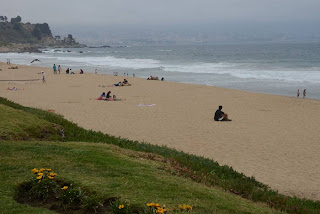Palacio de la Moneda - opened in 1805 as a colonial mint, but later the presidential palace. It was bombed during the 1973 military coup. Although the president no longer lives here, there is still a ceremonial changing of the guard. (Note the ubiquituous stray dog!)
Santiago cathedral on Plaza de Armas. Santiago was founded on 12th February, 1541 and because of earthquakes the cathedral has been rebuilt 5 times. A Royal Ordinance issued in Madrid in 1573, specified that all towns should have a main plaza surrounded by streets in a grid pattern. Another rule was that churches should preferably be on high ground so that they could be easily seen and the climb to them would force greater reverence.
Cherubs above the cathedral door.
Old and new architecture in Santiago.
Ornate iron roof of the Central Market.
There is still an impressive range of fish and shellfish for sale, but the fruit and vegetables have been relocated and the space taken over by restaurants.
Face painting is just as popular in Santiago as here.

Carabiniers in Santiago encouraging the perception that they are your 'amigos'!
Christmas street parade outside our hotel in Santiago.
I have always thought Valparaiso was a romantic name (like Samarkand and Timbuktu). It was raided several times by pirates (including Francis Drake) and later prior to the opening of the Panama Canal it became an important port. Unlike most Spanish colonial towns, it does not follow a grid pattern, but the houses tumble down the sides of 42 hills, ornate mansions side by side with adobe and corrugated iron shacks all painted in bright colours.
Some of the gullies are so steep, that houses which are single story facing the street, have 6 levels at the rear.
My photos don't show how steep the streets are.
Valparaiso's graffiti artists would give Melbourne's lane artists a run for their money!
A Mapuche witch. The Mapuche successfully resisted the Spanish for 300 years and only signed a treaty with independent Chile in 1881. As with other indigenous peoples around the world they got a raw deal and there is still discontent.
Political stencils.
Typical colourful corner shop.
One of the funicular railways which connect the lower and upper towns
The former Government House now the seat of the Admiralty

The beach at Vina del Mar, an upmarket seaside resort, just north of Valparaiso. The cold Humboldt current which flows north along this coast causes the fog which is an almost permanent fixture.
Typical apartments along the beachfront in Vina del Mar. Each block has its own funicular for access.
Merry Christmas! This blog is now going into hibernation until I dream up where to go to next.





















Welcome home, and thank you again for taking me to fascinating parts of the world. I'll look forward to seeing where you go next!
ReplyDeleteThank you for your travel tales and photos. Brilliant as usual. Now where to next!!!!! I look forward to the new installment in the future.
ReplyDelete